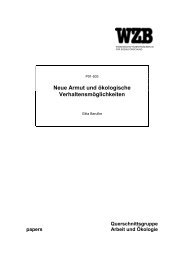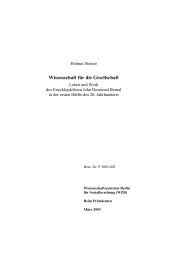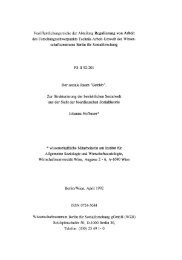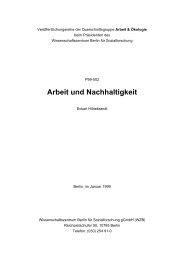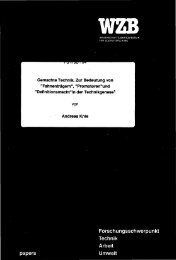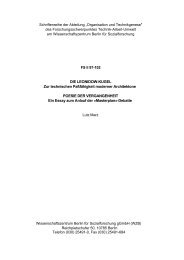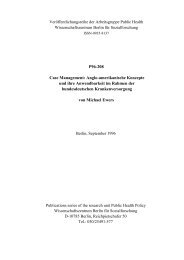New seminal environmental works. Nine review articles. - WZB
New seminal environmental works. Nine review articles. - WZB
New seminal environmental works. Nine review articles. - WZB
Create successful ePaper yourself
Turn your PDF publications into a flip-book with our unique Google optimized e-Paper software.
Udo E. Simonis 35<br />
(www.chelseagreen.com). An important innovation as regards contents<br />
consists in the update of empirical data and the more precise definition of<br />
what is to be understood by 'overshoot'. (Actually, that could have been<br />
made the main title of the volume). Probably the most important innovation<br />
of the book, however, is pedagogical: that is, the dialogical character of the<br />
text. The authors speak with the reader, they get him/her to understand the<br />
various scenarios and computer runs, and they involve him/her in a<br />
discourse on political priorities, on barriers to and chances of change - in<br />
the economy, in society, in every person.<br />
Global overshoots and systems collapse like the thinning of the<br />
stratospheric ozone layer, climate change, species loss, receding forests,<br />
population expansion, the persistence of hunger, growing water shortage,<br />
diffusion of toxic wastes, have made the authors more pessimistic than they<br />
were in their earlier <strong>works</strong>. But in the two chapters of the book on<br />
transitions to a sustainable system (pp. 235-264), and on tools for the<br />
transition to sustainability (pp. 265-284), they are (typically American?)<br />
full of optimism. And they give compelling reasons: "Once the limits to<br />
growth were far in the future. Now they are widely in evidence. Once the<br />
concept of collapse was unthinkable. Now it has begun to enter into the<br />
public discourse – though still as a remote, and academic concept"<br />
(p.XXII). A book might seem like a weak tool in the struggle to attain<br />
sustainable development, but where there has been an agrarian and an<br />
industrial revolution, there also could be a sustainability revolution.<br />
In a set of 10 scenarios up to the year 2100, the authors present possible<br />
futures. They do not predict the future, they just show how the twenty-first<br />
century may evolve (pp.169-249). In the first 8 scenarios the main system<br />
parameters – population, resources, food, industrial output, consumer




